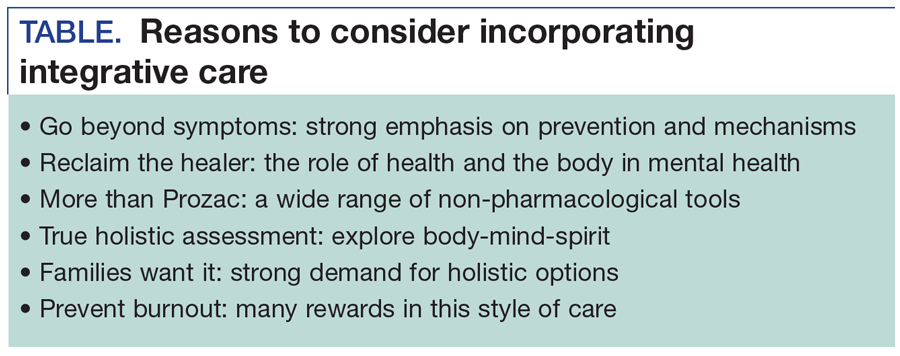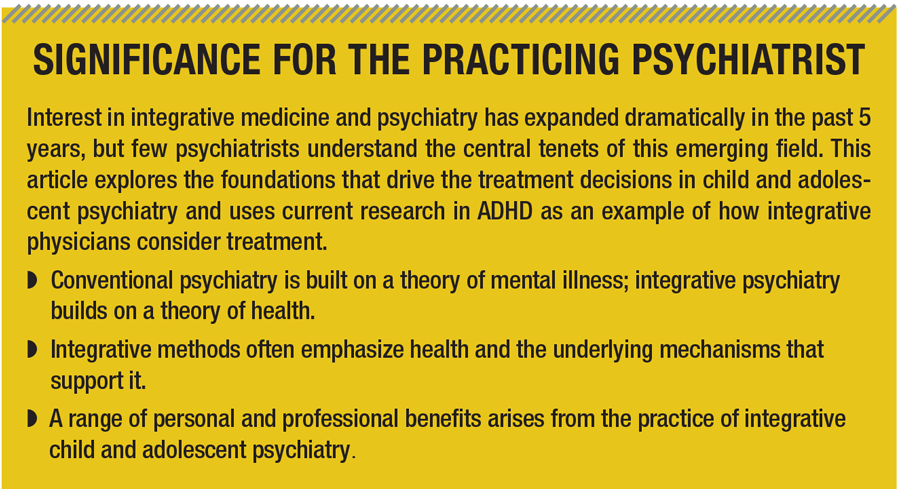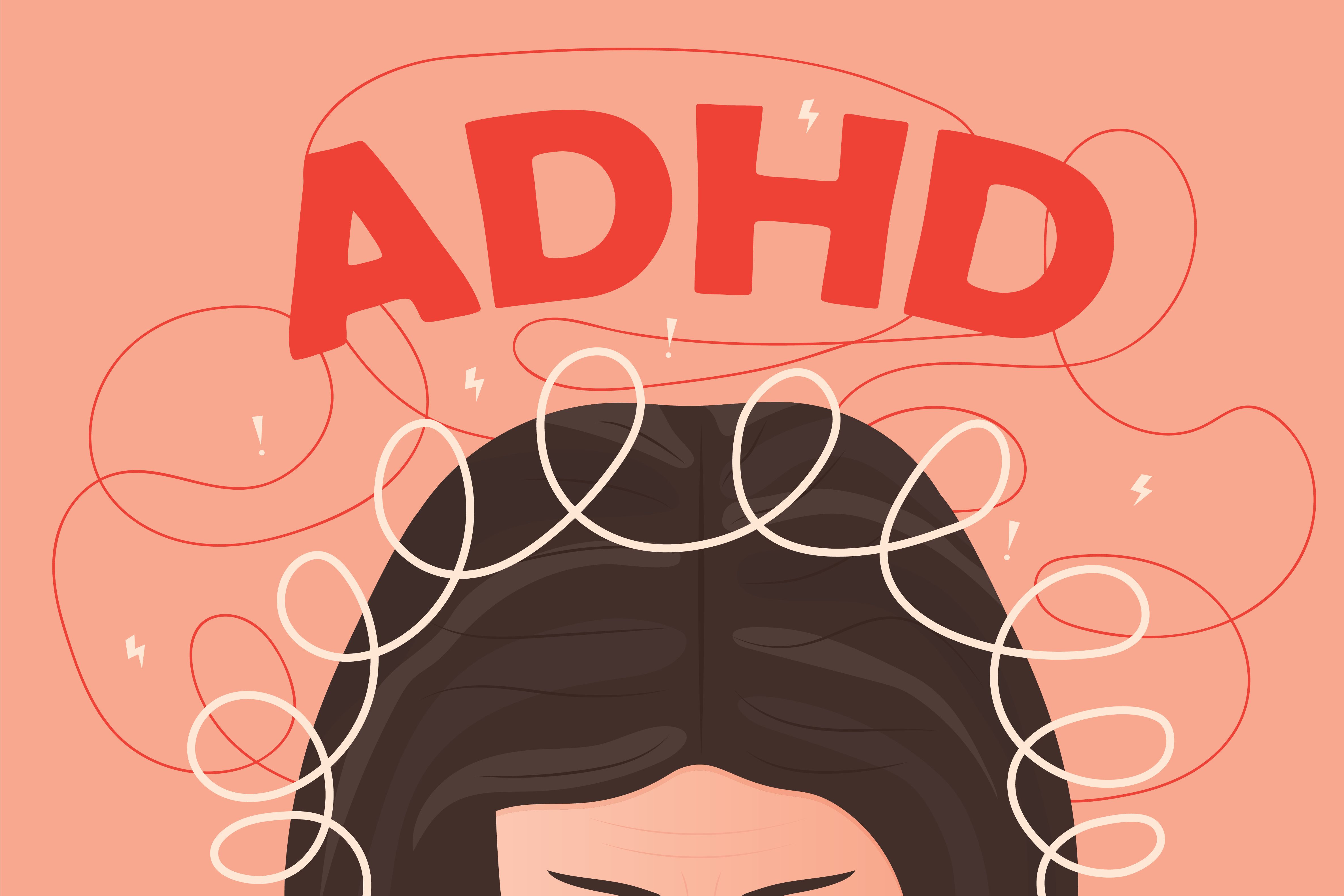Publication
Article
Psychiatric Times
The Premise, Practice, and Promise of Integrative Child and Adolescent Psychiatry
Author(s):
Integrative psychiatry helps us push deeper into the testing of metabolic, gut, and brain features, which seems more fitting, given our role as physicians.
© shutterstock.com

TABLE. Reasons to consider incorporating integrative care

SIGNIFICANCE FOR THE PRACTICING PSYCHIATRIST

If integrative child and adolescent psychiatry seems unclear, this is because its foundation is not well understood. Reviewing the evidence base of integrative child and adolescent psychiatric treatments offers only a limited understanding of this rapidly growly field. Instead, one must look at the philosophical foundations and the deeper motivations behind this paradigm shift to orient oneself to this emerging field. Using ADHD as an example, the broader context and utility of some of the most commonly used tools and techniques will be explored in this article.
The principles
For the past few years, there has been a growing hunger for a different perspective in psychiatry. Our profession is in crisis on many levels. From the vagaries of our diagnostic system to the limited evidence documenting efficacy for our riskiest medications, the concerns are myriad and well known. But here are a few more: Our reductionist model finds itself increasingly left behind by the expanding scientific potential in emerging arenas such as epigenetics and neuroplasticity. The production-oriented, pharmaceutically driven delivery system in the US feels increasingly heartless; it is frustrating and unrewarding for many practitioners.
Related content:
6 Myths About Integrative Psychiatry
The unfortunate truths have been most widely documented in adult patients, but the gaps in research and questions about treatment are most challenging among children, adolescents, and young adults, whose developing nervous systems have become a canary in a coal mine.
Integrative psychiatry emerged and developed in direct response to some of these growing imbalances. For example, in child psychiatry, we have no unified philosophical foundation to call upon or guide our work when we encounter a patient outside DSM diagnostic criteria. The extraordinary complexities of the human brain and behavior have led to this, but the profoundly eclectic mix of models of diagnosis and treatment shares almost no philosophical foundation. This impasse has increasingly pulled us into a narrow, pharmacologic system of care that focuses our attentions on pathology.
Related content:
6 Myths About Integrative Psychiatry
But often, we have no framework for what “health” means. What is mental health, for instance? How does our understanding of mental health inform care and treatment? It seems an obvious question, but the premise of mental health is missing from almost all major psychiatric textbooks and from psychiatric training in general. How can we treat or understand mental illness, in any sort of sophisticated, scientific way, if we don’t know what state we are attempting to return the patient to? Without this kind of bilateral framework, we are left with strategies that target the superficial relief of disparate symptoms but fail to restore patients to health.
The concepts of health, healing, and mental health form the bedrock of integrative psychiatry. It’s from this ground-level vantage that we can begin to see our treatments, our tools, our tasks, and our patients in a light that fosters healing rather than the absence of symptoms.
Integrative medicine seeks first to do no harm. Above all else, we want to protect the mind, body, and spirit of our patients. With proper support and the alleviation of obstacles, the mind, body, or spirit can often heal itself. This is one of the obvious though often overlooked facts of health, especially in the territory of the brain-that care comes best as a support mechanism, not an intervention. Sadly, there are no perfect treatments, which is why in integrative medicine we sometimes select a safe intervention over a more effective but risky one. With each intervention, you have to ask yourself, are you moving the patient closer to health, and at what potential cost?
Faced with the same patient, a conventional psychiatrist and an integrative psychiatrist will sometimes create different treatment models. The philosophical foundations of the 2 (fighting illness vs supporting health) are in stark contrast and filter treatment choices accordingly. One example of the vast difference is the emphasis integrative medicine places on gut health and diet that much mainstream science now considers a primary influence on mental health.1-4 In fact, I’d wager that no single tool possesses more power to transform our genetic expression than diet and nutrition.
Our brains are made up of the molecules we ingest, yet you will not find a mention of diet, food, or nutrition in any psychiatric textbook. Integrative medicine prefers-or is willing to try-these sorts of health-empowering interventions over the introduction of treatments that might increase dependency or offer only brief, symptomatic relief. For instance, an integrative psychiatrist might offer a patient struggling with anxiety meditation, yoga, or inositol, before benzodiazepines or SSRIs are discussed.
Integrative medicine is not anti-medication, but by shifting the treatment model away from treating disease and toward supporting health, it understands medication as merely one possible intervention in a spectrum of possible interventions. This means every intervention must be evaluated according to an assessment of health vs illness and safety vs effectiveness. And all too often medications cause some damage in the search for long-term health.
Practice: ADHD
ADHD is the most studied illness in child psychiatry, yet we have insufficient clinical understanding about prevention, pathology, and prognosis. Rather than a true illness, what we have is a broad syndrome based on commonly observed concerns, such as attention and focus. Given this, the integrative psychiatrist searches for barriers to health and factors that can support a return to health.
Related content:
Mini Quiz: Integrative Child Psychiatry
Any child can realize significant gains from physical activity. Compared with seated reading, concentration, inhibitory control, and academics improved with a single 20-minute session of moderate physical activity.5,6 A large randomized, controlled trial (RCT) of children aged 7 to 9 demonstrated that 70 minutes of exercise after school improved executive functioning, attention, inhibition, and cognitive flexibility. This study was notable because it also showed significant EEG changes in the children.7
Like holistic medicine, integrative psychiatry emphasizes the body’s influence on mental health. This in turn leads to much more laboratory data to explore this link. For example, during assessment for ADHD, the conventional path generally leads to a stimulant prescription without further workup than a Connors checklist and a personal evaluation. An integrative child and adolescent psychiatrist will order significant blood work. Ferritin levels offer an insight into dopamine metabolism-iron is a critical cofactor for dopamine hydroxylase in the CNS. Studies have shown that ferritin levels in the brain of children with ADHD are decreased and that ferritin levels predict stimulant response.8,9
Interventional studies of iron supplementation have been positive.10 Data from 2 studies suggest a link between serum ferritin levels and ADHD11,12; however, the link was not confirmed in one study.13 Although there are no ongoing large RCTs, the physiology makes sense and treatment with low-dose chelated iron is a safe and inexpensive choice that clearly makes sense once a clinically relevant iron deficiency is documented.
Omega-3 essential fatty acids (EFAs) also have a proven track record in treating ADHD. In a meta-analysis of 10 studies of omega-3 EFAs in ADHD, Bloch and Qawasmi14 found an effect size of 0.4. While this does not match the effect size seen with stimulants, EFAs improve health, have little risk, and are also likely to improve mood and reduce the stimulant dosage.
In an effort to better understand and implement the efficacy of EFAs, some integrative practitioners have started to measure the ratio of omega-6 EFAs, such as arachidonic acid (pro-inflammatory), to omega-3 EFAs, such as eicosapentaenoic acid (anti-inflammatory), with an assay that looks at membrane status.
Sorgi and colleagues15 measured these ratios in a small study. Children who had ADHD received supplemental omega-3 EFAs. The researchers found that when the ratios of EFAs in the children’s tissues-initially over 15-dropped to less than 7, the Connors status normalized. These benefits take 3 months because this is a nutritional effect. Also, it seems that for ADHD issues, eicosapentaenoic acid is more useful than docosahexaenoic acid. This is a great example of how an understanding of the nutritional mechanisms and physiology underlying health (in this case, inflammation and membrane fluidity) can affect the treatment of mental illness.
Ongoing research
Perhaps the most promising ongoing research is the multicenter examination of neurofeedback sponsored by the National Institute of Mental Health. Gene Arnold, MD, of Ohio State University-the lead author of the Multimodal Treatment of ADHD (MTA) study-has collaborated with eminent neurofeedback researchers such as Joel Lubar, PhD, to create a sophisticated study design that should deliver definitive answers about the efficacy of neurofeedback for the treatment of ADHD. Results are expected in 3 or 4 years.
Robert Hendren, MD, and others at the University of California, San Francisco, are looking at the biomedical basis of autism by exploring mitochondrial dysfunction, allergies, and immunology. Other areas of interest with a significant or growing research base on ADHD include food sensitivities/allergies, phosphatidylserine/omega-3 combinations, pesticide exposure, zinc, electronic overstimulation, ADHD phenotypes diagnosed with quantitative EEG, inflammation, immune dysfunction, microbiome/probiotics, atopic illness, and sleep-related issues.
The link between mercury in vaccines and autism has been disproven, but the issue of environmental mercury exposure and risk of ADHD looks real.16 Clearly, more research is needed, but the explosion of findings in the realms of inflammation, microbiome, neuroplasticity, pediatric acute-onset neuropsychiatric syndrome/pediatric autoimmune neuropsychiatric disorders associated with streptococcal infections (PANS/PANDAS), population nutrition, and epigenetics augurs well as these key areas are targeted for more exploration.
Conclusion
Taken as a whole, integrative psychiatry pushes conventional psychiatry in a few directions. It encourages the comprehensive assessment of the whole person and his or her physical health, while moving away from the mechanization of specific pills for specific ills. This allows psychiatry to finally reclaim its management of not just neurotransmitters but of the mind and body. It helps us push deeper into the testing of metabolic, gut, and brain features, which seems more fitting, given our role as physicians. In turn, this science aids assessment and treatment, and moves us closer to understanding the mechanisms of illness rather than relying on DSM criteria. By leveraging the value of physiological assessment, we move closer to the promise of a psychiatry grounded in pathophysiology. The benefits that accrue in the practice of integrative child and adolescent psychiatry are both professional and personal (Table).
Perhaps most of all, the work of integrative psychiatry offers a deeper and richer connection with each child, adolescent, and parent, as we listen, assess, and care, while working to foster health in growth and development. Integrative psychiatry embraces, at its core, this central clinical task. It is an effective complement for much of what we do now and a challenge to do better in the future.
Disclosures:
Dr. Shannon is Assistant Clinical Professor, Department of Psychiatry, University of Colorado in Fort Collins, CO. He is the founder of a comprehensive integrative mental health clinic, the Wholeness Center, and author of numerous articles and textbooks, including Mental Health for the Whole Child. He receives royalties from books that he has written on this subject.
References:
1. Baskin R, Hill B, Jacka FN, et al. The association between diet quality and mental health during the perinatal period: a systematic review. Appetite. 2015;91:41-47.
2. Jacka FN, Rothon C, Taylor S, et al. Diet quality and mental health problems in adolescents from East London: a prospective study. Soc Psychiatry Psychiatr Epidemiol. 2013;48:1297-1306.
3. Jacka FN, Kremer PJ, Berk M, et al. A prospective study of diet quality and mental health in adolescents. PLoS One. 2011;6:e24805.
4. Jacka FN, Kremer PJ, Leslie ER, et al. Associations between diet quality and depressed mood in adolescents: results from the Australian Healthy Neighbourhoods Study. Aust N Z J Psychiatry. 2010;44:435-442.
5. Pontifex MB, Saliba BJ, Raine LB, et al. Exercise improves behavioral, neurocognitive, and scholastic performance in children with attention-deficit/hyperactivity disorder. J Pediatr. 2013;162:543-551.
6. Kamp CF, Sperlich B, Holmberg HC. Exercise reduces the symptoms of attention-deficit/hyperactivity disorder and improves social behaviour, motor skills, strength and neuropsychological parameters. Acta Paediatr. 2014;103:709-714.
7. Hillman CH, Pontifex MB, Castelli DM, et al. Effects of the FITKids randomized controlled trial on executive control and brain function. Pediatrics. 2014; 134:e1063-e1071.
8. Cortese S, Azoulay R, Castellanos FX, et al. Brain iron levels in attention-deficit/hyperactivity disorder: a pilot MRI study. World J Biol Psychiatry. 2012; 13:223-231.
9. Calarge C, Farmer C, DiSilvestro R, Arnold LE. Serum ferritin and amphetamine response in youth with attention-deficit/hyperactivity disorder. J Child Adolesc Psychopharmacol. 2010;20:495-502.
10. Konofal E, Lecendreux M, Deron J, et al. Effects of iron supplementation on attention deficit hyperactivity disorder in children. Pediatr Neurol. 2008;38:20-26.
11. Konofal E, Lecendreux M, Arnulf I, Mouren MC. Iron deficiency in children with attention-deficit/hyperactivity disorder. Arch Pediatr Adolesc Med. 2004;158:1113-1115.
12. Bener A, Kamal M, Bener H, Bhugra D. Higher prevalence of iron deficiency as strong predictor of attention deficit hyperactivity disorder in children. Ann Med Health Sci Res. 2014;4(suppl 3):S291-S297.
13. Romanos M, Tiesler CM, Koletzko S, et al. No cross-sectional and longitudinal association of ferritin and symptoms of attention-deficit-/hyperactivity disorder in a large population-based sample of children: results from the GINIplus and LISAplus studies. Atten Defic Hyperact Disord. 2013;5:313-320.
14. Bloch MH, Qawasmi A. Omega-3 fatty acid supplementation for the treatment of children with attention-deficit/hyperactivity disorder symptomatology: systematic review and meta-analysis. J Am Acad Child Adolesc Psychiatry. 2011;50:991-1000.
15. Sorgi PJ, Hallowell EM, Hutchins HL, Sears B. Effects of an open-label pilot study with high-dose EPA/DHA concentrates on plasma phospholipids and behavior in children with attention deficit hyperactivity disorder. Nutr J. 2007;6:16.
16. Yoshimasu K, Kiyohara C, Takemura S, Nakai K. A meta-analysis of the evidence on the impact of prenatal and early infancy exposures to mercury on autism and attention deficit/hyperactivity disorder in the childhood. Neurotoxicology. 2014;44:121-131.






